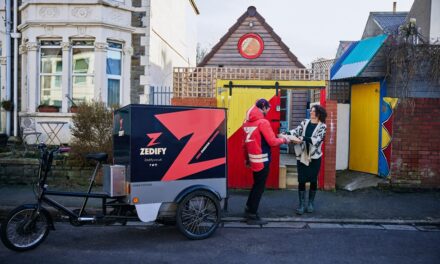
More to door
While the ecommerce sector rests on efficient delivery, customers are more interested in knowing when an order will arrive than getting it quickly, reports Sean Hargrave
Although some consumers may have been confused at the Post Office counter, the evidence is that the country's etailers were ready for the Royal Mail's Pricing in Proportion (PiP) scheme introduced last month.
PiP changed the way the Royal Mail charges for deliveries by considering an item's size as well as its weight – hence the addition of a 'large letter' category for letters larger than the normal C5 business letter yet smaller and lighter than a parcel. In all, 80% of items carried by Royal Mail will either remain the same price or be cheaper, a spokesman predicts.
The Royal Mail's optimistic vision that the scheme has been introduced without disruption has been mostly backed up by ecommerce sites. Online photo print service Photobox's MD Mark Chapman, for example, says there was enough warning of changes to the pricing of the million packages it sends through Royal Mail each year and that the moves are sensible.
"We'd been consulting with Royal Mail for a year or so, so every major ecommerce provider would have known about the changes," he says. "Overall, we reckon our post bill will come down. I think, though, for the next couple of months ecommerce players are going to be in flux as they wait for their bills from Royal Mail to confirm they've got the savings they were expecting. When we have confirmation we'll be able to pass on the savings through our prices."
Arriving ASAP
With the Royal Mail and its parcel delivery service ParcelForce claiming a 60% market share for ecommerce deliveries in the UK, its price changes will have a significant effect. Last Christmas it delivered 70m items ordered online, double that of the 2004 festive season.
The change will only affect standard delivery because it's here that Royal Mail is most competitive. With its obligation to deliver any package under 20kg to any home in the UK, and its network of 1,400 delivery offices from which undelivered parcels can be collected, its wide reach is used by most etailers as a general service. Couriers tend to be used for higher value and heavier items where the etailer wants to get a signature or an offer from the courier company to try at least two or three times to deliver an item.
It's the courier side of the market that experts are predicting will play the bigger part in shaping the future of the e-fulfilment market as consumer demand for named- or even same-day, services prompts a shift away from the normal choice between a two-to-three-day standard delivery and next-day 'express' delivery.
In a market where Amazon's lead with despatch notification emails and 'where's my stuff' order tracking has now largely become standard, etailers are predicting the main room for improvement is now in delivery options and how the goods arrive at the doorstep. Leading the charge, in London at least, for same-day – even same-hour – deliveries is Thomas Allason. He set up eCourier two years ago after a bad experience trying to get tennis tickets biked across London to friends.
"We're convinced that etailers are going to want to be able to offer a kind of panic button for people who need a gadget or book, or whatever it is, right now," he says. "The trouble is, we discovered when we studied how courier companies are run that they're just so inefficient. Hence, with our software, we've cut down on many of the people in the cluttered process and we have satellite-tracked couriers to whom we allot jobs through a system that knows how long such jobs have taken in the past. When a delivery's made, the client gets an email with the name and signature of whoever received the item."
The system is being used for general B2B deliveries but was trialled during the World Cup by Krispy Kreme to deliver doughnuts within an hour in London. Allason is currently delivering ice cream to other ecommerce providers to prove that he can keep to his one-hour promise.
"We're talking to the big ecommerce companies," he says. "We're currently working on rolling out to cover the country during 2007 and we see no reason why we can't expand our model and our network. It would mean online shoppers having an 'I want it now' button. To give an idea of price, it would cost about #8 for a London delivery, which isn't bad when you look at what some people are asking for next-day delivery."
Willing to wait
However, not many fulfilment firms or etailers are reporting a strong desire among the public to receive goods on the same day they're ordered.
Indeed, Pascal Finette, VP of business development at ecommerce technology firm Channel Advisor, argues that promising such a prompt service could be a brand's undoing. His company provides online sales and fulfilment software and consultancy for the likes of IBM and Motorola. His experience is that brands shouldn't focus on services that are difficult to achieve and aren't visibly being clamoured for.
"No one should forget the American example of Web Van, which was going to deliver groceries within two hours," he warns. "The idea proved to be nuts and it went bust after spending millions on a massive distribution network.
"Brands can offer half-hour or one-hour delivery services in really built-up places, such as Tokyo, where it's very popular and they have a fleet of scooters. The problem is that outside really dense urban areas you can't offer a service like that and people are less willing to pay for it.
"Our experience is that customers will usually happily wait two or three days, but beyond that they get disappointed. They like the option of next-day delivery but only around 10% will go for it because you have to spend quite a bit of money – say #50 or more – before next-day delivery prices don't seem punitive compared to the cost of the goods," says Finette.
At Zendor, which handles e-fulfilment for JJB Sports, River Island and Early Learning Centre among others, the estimation is that around one in ten customers will pay for express delivery, with the vast majority of customers opting to spend the least possible. Its commercial director, John Garrick, believes that customers are more interested in cost than timing.
"Our biggest impact comes when a provider offers a promotion such as free delivery for goods over a certain limit," he says. "Customers react very strongly to such offers and they're more efficient for the retailer."
This sentiment is shared by Steve Law, operations director at gadget site Firebox. He believes same-day delivery is a misnomer for which no one will pay. Far better, he suggests, to work with couriers on named- day services.
"We have express delivery options that allow you to opt for morning or afternoon delivery for #7.95 or Saturday delivery for #9.95. We find, though, that four-fifths of our customers stick with the standard delivery," he says.
"It's why we're working to integrate better with couriers, to understand when they deliver to certain areas so that we can specify a day to people. That's going to be the really big push for fulfilment as it will be far more popular than expensive same-day services," Law adds.
To highlight the potential cost of actually offering same-day services, and not just talking about them as a good idea, Stewart Hayward, commercial director at computer reseller WStore, points out some rather sobering figures.
"We can offer same-day delivery but it tends to be used only by people whose company system has gone down and they need a new cable to get up and running," he says. "So they spend a couple of quid on a new cable but #300 for a bike to drive halfway across the country. There are only ever going to be so many people who will pay for that. That's why we offer next-day delivery, which is basically the same as named-day."
Paying for delivery
At a time when it would appear that many etailers are offering such similar fulfilment service levels and so making it hard for companies to compete on their order tracking and delivery services, organisations can still improve by focusing on the reliability of their service, according to Stephen Bentley, chief executive at marketing and fulfilment provider Granby.
He claims that offering a 100% real-time parcel tracking service allows his company to differentiate itself. Such a guarantee is fundamentally important for the Key Stage 1, 2 and 3 exams it's responsible for delivering, as well as the 375m vouchers from 27,000 schools involved in the Sainsbury's Active Kids programme it operates for the supermarket.
"Everyone has ISO9000 or Investor in People accreditation and we're all members of the DMA, so accounting for every parcel in a browser window with live information from DHL is a great way to differentiate oneself," says Bentley.
Just as one can stand out for delivery reliability, fulfilment can also be used to boost brand image. In an age when white vans, stub pens and clipboards are still common, Comet, like many large retailers, is focusing on keeping control of the entire fulfilment process to ensure consistency. Branded vans and uniformed delivery staff add a reassuring finishing touch for online shoppers, believes Comet's business development manager Tony McAlpine.
"It's important that the customer experience is as professional as possible, which if you have full control can be easier to manage," he says. "But this needs to be counter-balanced by the costs of providing in-house delivery and so isn't possible for smaller products. Our customers need a greater reassurance that their item's going to arrive, so our reputation and delivery guarantee help to provide a level of reassurance."
One of the biggest changes for Christmas deliveries this year will undoubtedly be etailers changing box sizes to ensure, where possible, that what were parcels will now be considered large letters. This was the experience in Germany, says Channel Advisor's Finette, when Deutsche Post brought in similar weight and size tariffs a couple of years ago. Hence, anything that can be folded into a smaller box will be.
However, the new options are unlikely to affect same-day delivery. This, according to e-fulfilment experts, will remain a costly dream rather than a reality for all, bar same-city proof-of-concept experiments.
Quick Take
* Royal Mail handles 60% of the country's e-fulfilment
* In August it introduced Pricing in Proportion rates that could save many etailers money – those sending small, heavy items or large, light items will pay more
* Etailers are waiting for their first post bills during September before considering reducing delivery charges in the run-up to Christmas
* The festive season is likely to see the start of more etailers offering named-day and next-day services
* Despite at least one courier claiming it could offer a cut-price same- day delivery service in London, most fulfilment experts believe same- day deliveries aren't as important as next- or named-day services, and would be too costly to roll out outside London












